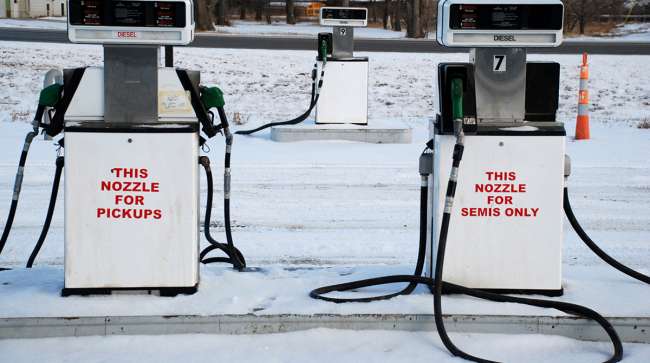Diesel Climbs Again, Rises 2.3¢ to $2.996 a Gallon

The U.S. average retail price of diesel jumped 2.3 cents to $2.996, while oil hovered near $62 a barrel and domestic crude inventories declined.
Diesel costs 39.9 cents more than it did a year ago, when it was $2.597 a gallon, the Department of Energy said Jan. 8.
Average regional prices for trucking’s main fuel rose in all areas except the Rocky Mountain region, where the price dipped 0.7 cent to $2.974.
Prices rose past $3 per gallon on the East Coast, New England, Central Atlantic, West Coast and California regions.
Later in the week, oil closed above $63 a barrel for the first time in more than three years as crude stockpiles stowed in American tanks and terminals dwindled for an eighth straight week, Bloomberg News reported.
U.S. commercial crude oil inventories for the week ending Jan. 5 fell to 419.5 million barrels, down 4.9 million barrels from the previous week, DOE’s Energy Information Administration reported. U.S. crude inventories are in the middle of the average range for this time of year.
Also, the U.S. average price for regular gasoline rose 0.2 cent to $2.522 a gallon, EIA said.
Weekly gasoline prices climbed in all regions except the Lower Atlantic and Midwest regions, EIA said.
At the same time, the major snowstorm that blasted its way up the East Coast on Jan. 4 did little to dent fuel demand, according to Bloomberg News.
Vehicles that do hit the roads in storms idle longer and power outages send shivering residents to gasoline or diesel generators to heat their homes, Dan McTeague, a Toronto-based analyst with GasBuddy.com, which monitors pump prices, told Bloomberg.
“Short of blizzards where people are actually stuck, cold weather doesn’t prevent people from driving,” McTeague said. “What it does do is cause more consumption.”
Meanwhile, as the cost of fuel is rising, most owner-operators and small carriers running in the spot market are operating without a separate fuel surcharge, unless it is baked into a lane rate, experts said.
“A lot of them don’t understand the fuel surcharge or even how to put a fuel surcharge together given the various options to determine the base price of fuel, said owner-operator Chad Boblett, who runs Boblett Brothers, in Lexington, Ky.
He and a broker once developed a fuel surcharge for a particular load, but because the shipper had not even seen it calculated that way, the shipper rejected it, Boblett said.
The fuel surcharge is not a charge by the carrier; it is typically an accommodation by the shipper or the broker, said David Owen, president of the National Association of Small Trucking Companies.
“Truthfully, it is reflected in the spot market rate with most brokers,” Owen said, adding the fuel surcharge was designed for contracts and continuing movements over a period of time.
Currently, small fleets are not breaking out fuel surcharges in the paperwork they submit to Nashville, Tenn.-based Bibby Transportation Finance, leading Mary Ann Hudson, Bibby’s executive vice president, to believe they have gotten away from them.
Bibby Transportation Finance is a unit of Bibby Financial Services, which is a subsidiary of Bibby Line Group, based in Liverpool, England.
“I think [small carriers] could be blending [a surcharge] in with what they are charging to get the load. I don’t think you are seeing as much of the flat-out fuel surcharge right there on the invoice,” Hudson said.
At the same time, West Texas Intermediate crude futures on the New York Mercantile Exchange closed at $61.73 on Jan. 8, compared with $60.37 on Jan. 2.
However, on Jan. 10, oil settled at $63.57 a barrel on the Nymex.
Oil has held above $60 a barrel since late December in New York with U.S. crude stockpiles contracting and American oil drilling stalling out. Also, output curbs by the Organization of Petroleum Exporting Countries and allied suppliers have buoyed prices, with producers promising to continue the curbs for all of 2018, according to Bloomberg.
The weekly U.S. oil rig count was 742 during the week of Jan.5, down five from the week before and 213 more than a year earlier, oil field services company Baker Hughes Inc. reported.
In the midst of investor pressure, explorers are seeking to do more with less in a bid to boost profits, including opening already-drilled wells by fracking them rather than deploying more rigs to start new ones, Bloomberg reported.
Houston-based Baker Hughes ranks No. 15 on the Transport Topics Top 100 list of the largest private carriers in North America.




